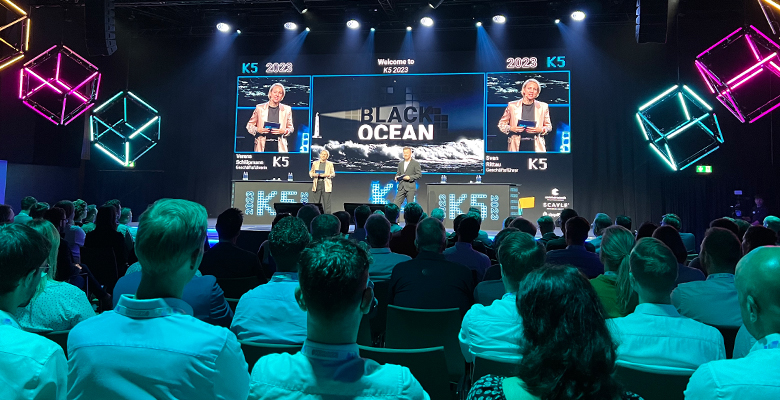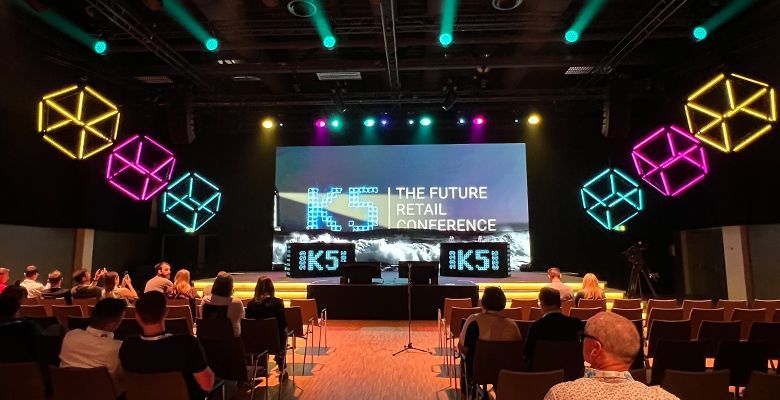After years of growth, many merchants find themselves challenged this year by a consumer crisis - mainly caused by the war in Ukraine and inflation throughout the Euro zone. But the consequences of the war are just one part of the truth - the others are failed product catalog strategies and missing real innovations in e-commerce.
Starting from here, we found ourselves immersed in the vibrant atmosphere of the K5 Future Retail Conference held in Berlin - looking for answers, together with 4,000 other attendees.
Learn from the best, meet the best, be the best!
The event, a melting pot of innovation and industry expertise, is serving as a milestone for the retail industry, marking a turning point in the way we think about the future of commerce. This year’s theme, „Into the black“, echoed through the halls. Expert speakers from various disciplines took the stage, delivering thought-provoking keynotes and engaging panel discussions. Their insights into emerging trends, disruptive technologies, and evolving consumer behavior captivated the audience and ignited a collective sense of momentum to use these challenging times as an opportunity to change for the better.
Sustainability and ethical practices were at the forefront of discussions. Thought leaders shared strategies for creating a more eco-friendly and socially responsible retail ecosystem, inspiring attendees to adopt greener practices. Circular economy models, zero-waste packaging, and renewable energy solutions were just a few of the topics explored, sparking a collective commitment to a more sustainable future.
As the sun set on the first day of the conference, a sense of accomplishment filled the air with the K5 Commerce Awards ceremony and the following aftershow party.
After intense two days, attendees departed with their minds buzzing with new ideas, armed with insights and connections that would shape the future of retail – and especially with the following 5 key takeaways:
#1 | Merchant profits can be leveraged best by the mean of transparent pricing
While directly impacting revenue, effective pricing allows merchants to differentiate their products from competitors. Customer’s on the other hand value transparent pricing strategies more than ever. Finding the right balance between both will be essential to create demand in the future.
#2 | The old e-commerce 1.0 model of prices & availability is not working anymore
Today’s customers are more informed, empowered and demanding. At the same time, they have a wide range of options to choose from and are looking for additional value propositions such as convenience, personalized experiences, and superior customer service. Purchasing decisions are no longer made solely on the basis of the cheapest price and availability.
#3 | Innovation based on an accurate understanding of customer needs is key
From a customer’s perspective, the last real innovation in e-commerce has been Responsive Web Design delivering shopping experiences across a broad range of mobile devices. Ever since, we saw numerous ‘innovations’ coming and going such as blockchain, composable commerce or personalization – none of which were yet able to add a comparable value to the customer. For a long time, AI has not been openly available to everybody and was therefore perceived as an abstract ‘tech thing’. Nowadays, a new generation of AI such as ChatGPT is shaping the customers’ expectations and merchants are well advised to leverage this groundbreaking innovation to their advantage – by making use of their customer data to offer real personalized product assortments and shopping experiences.
#4 | Customizing only pays off in areas influencing the customer’s willingness to pay (more)
It is important for businesses to carefully evaluate the areas where customization brings the most value to customers and justifies the associated complexity. Focusing customization efforts on those areas will provide a more targeted and efficient approach, delivering the desired benefits without unnecessarily increasing complexity in other areas.
#5 | Products, services and assortment that are relevant to the target group are the future key differentiator
Over the course of the last years, we saw merchants vastly expanding their product catalogs hoping to reach more customers and increase sales. Lots of resources were put into that expansion process as well as managing all the challenges coming with it.
As a result, we see now a crowded and highly competitive marketplace in which a relevant product catalog that stands out and addresses the target group’s needs will provide a significant competitive advantage. Radically re-thinking product data and storytelling leads merchants to creating ‘story data’ instead – allowing them to set a new standard for describing products to their customers while creating their own unique brand identity.


K5 Future Retail Conference: Unleashing innovation, collaboration and change
Looking back at this transformative event, it becomes evident that the conference acted as a catalyst for innovation, collaboration, and change. The retrospective picture of the K5 Future Retail Conference in Berlin reveals a vibrant tapestry of cutting-edge technology, forward-thinking strategies, and a collective commitment to shaping a future where retail thrives at the intersection of human ingenuity and technological advancements.
And we are already looking forward to get disrupted again next year!








